Flint chief vows to do a lot more for sustainability in India
Upal Roy, managing director for India/South Africa/ME at Flint shares a bird’s eye view of the company’s 20,000 MTPA production capacity and philosophy. On the sidelines of the LMAI Conference in Jaipur, Roy tells Noel D’cunha that “Flint’s central premise is that products should be conceived from the start with intelligent design and the intention that they will eventually be recycled.”
16 Oct 2023 | By Noel D'Cunha
Noel D’cunha (ND): The last time we spoke, the Flint Group presence in India had plants in Vadodara and Hosur with a production capacity of 20,000 MTPA. What’s the update for 2023?
Upal Roy (UR): We have enough capacity on the ground. Our plan is to enhance our capacity utilisation while continuing to work on improving our value proposition in front of the customer. So rather than investing in new capacity, we’d like to focus on what we’re doing well at and what we can do better.
ND: Flint Group has launched a new sustainability framework highlighting its plans to minimise its overall environmental impact? What is the impact on India?
UR: Our global alignment means we discuss worldwide sustainability initiatives with the India team. This includes introducing sustainable products launched globally to the Indian subcontinent at the right time.
ND: Can you share an example?
UR: Looking at compostable inks as an example, we’re working with certain customers in the Indian subcontinent to look at reducing their carbon footprint. We’re governed by the same values, and sustainability is one of Flint Group’s core values. In that sense, it doesn’t matter whether you’re in India or not
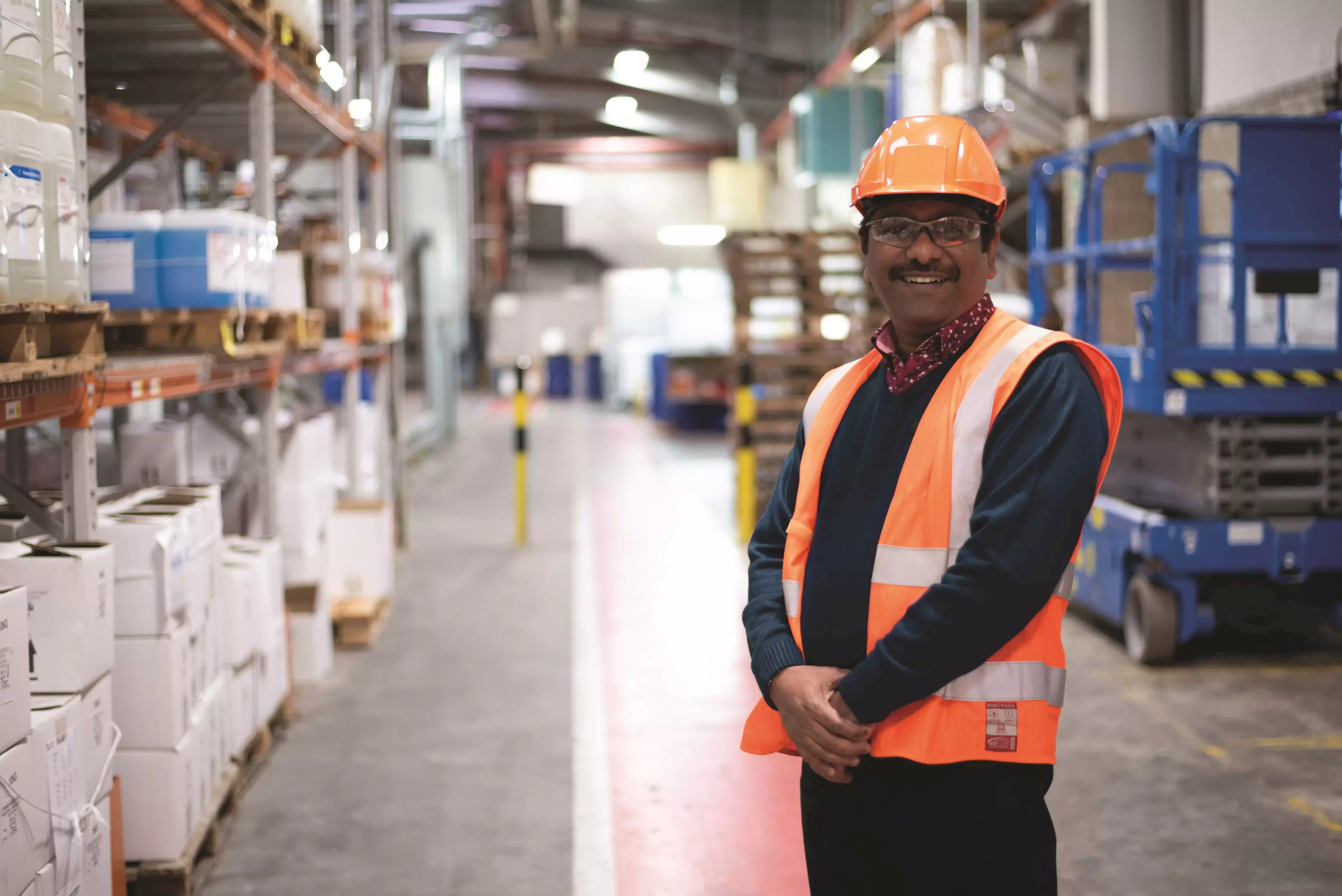
Flint plants in Vadodara and Hosur with a production capacity of 20,000 MTPA
ND: Flint operates in gravure, flexo, water-based flexo and UV labels in India. Your view on aqueous inks being sustainable and bio-renewable? How should the ink and printing ink industry move forward with this technology?
UR: There’s a lot of interest in water-based inks and whether it can be used on flexibles. Obviously, water-based inks can be used for corrugated and so on – that’s not an issue. The issue is whether they are suitable for flexible printing, especially for gravure applications. This is particularly relevant in the Indian market, where gravure printing accounts for over 95% of the industry.
ND: How does one make it suitable for gravure printing?
UR: From the gravure perspective, it would mean modifying cylinders for running water-based inks where, traditionally, solvent-based inks have been used. It would mean improving the drying capacity of the presses. And finally, it would mean making the product not just sustainable, but cost-effective as well.
ND: Any update on this front from Flint?
UR: From our side, we have a product that we have trialled, and feedback has been positive. But we’ll have to introduce it carefully and in a structured manner. This will ensure people can modify their presses and cylinders. Discussions have started with certain customers, and some are further down the road than others. The key will be making it suitable for gravure as this is more challenging than using water-based inks for flexo.
ND: What should the Indian packaging industry promote – paper packaging or recycling?
UR: We are agnostic on what to promote. We operate from the point of view of making solutions cost-effective for our customers while also minimising their footprint. The customer’s needs determine the choice.
ND: Is cost a concern?
UR: We do have products which can be looked at from the point of view of what’s more cost-effective versus what’s more sustainable. When considering paper versus film, we do have products for both, and ultimately the question is – which is the better product for the customer’s requirements.
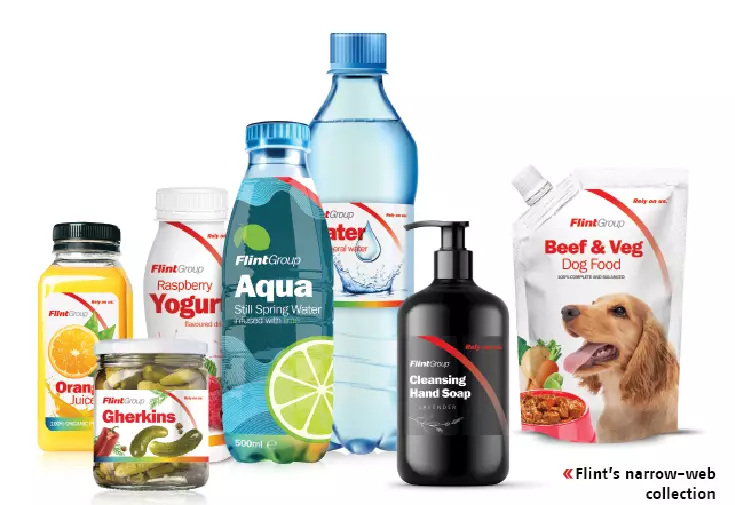
ND: Replacing multi-layers with barrier coatings – the pros and cons of driving packaging business?
UR: Sometimes you would think a multi-layer would work better, but keeping in mind the end requirements, sometimes, it doesn’t work as well as you would hope. Ultimately, the better thing to look at when using a multi-layer is to use multi-layers from the same family, which promotes better recyclability. It is the best solution for the end-user, rather than simply assuming that mono-layer is better than multi-layer.
ND: What is the possibility of Flint making sustainable pigment intermediates in India?
UR: We do global sourcing where it’s needed. We have to keep in mind the business requirements and economy of scale. From that perspective, a plant that only serves India is not something we are looking at right now.
ND: Direct food contact pigments – is there any future?
UR: Direct food contact pigment is a complex subject for the food packaging industry. Moreover, using direct food contact pigments alone will not serve the purpose as printing ink is a combination of pigment/polymers/solvent, and each component should comply with direct food contact to meet the final requirement. Therefore, giving equal importance to other packaging components is also necessary.
ND: Low-migration additives for food packaging – should we invest more?
UR: The transfer of a substance from the packaging to the food, or vice versa, is the prime concern in the supply of materials for food packaging. Some additives used in food packaging are prone to migrate in food through the substrate if there is an insufficient barrier, and the use of low migration additives can help in this case. Therefore, focusing on low-migration additives for food packing is a necessity. In this regard, there is a strong emphasis from Flint Group to continue to look for low-migration alternatives
ND: How does Flint propose to minimise the depletion of renewable resources to maintain the ecological balance?
UR: Flint Group has committed to setting a science-based target (SBT) to reduce our carbon footprint. Our single biggest emissions category is the raw materials we buy. We are currently engaging suppliers to understand how they will reduce the carbon footprint of the products they supply to Flint.
ND: What is your view about bio-based materials?
UR: For some raw materials using bio-based feedstock may be part of the solution, and we are evaluating these options along with others, such as recycled raw materials and suppliers ‘greening’ their energy mix. The point is, when reviewing the potential to reduce the carbon footprint of raw materials, we are assessing options on their wider environmental impacts (biodiversity loss, competition with food) alongside the potential carbon emission impacts.
ND: Is it possible to design with 100% sustainable printing inks?
UR: First, we need to define what ‘sustainable ink’ is. Our customers see sustainable inks in two key facets, low-carbon and recyclable. Our approach to sustainability mirrors that of our customers. In our prism of sustainability framework, we are committing to designing products for the circular economy and reducing the carbon footprint of our products. However, there is a trade-off between these two aspects of sustainability, a higher carbon footprint product that has barrier properties might enable mono-material packaging formats that are easier to recycle. In a way, this can reduce the whole life cycle footprint of the package despite slightly more carbon emissions associated with the ink.
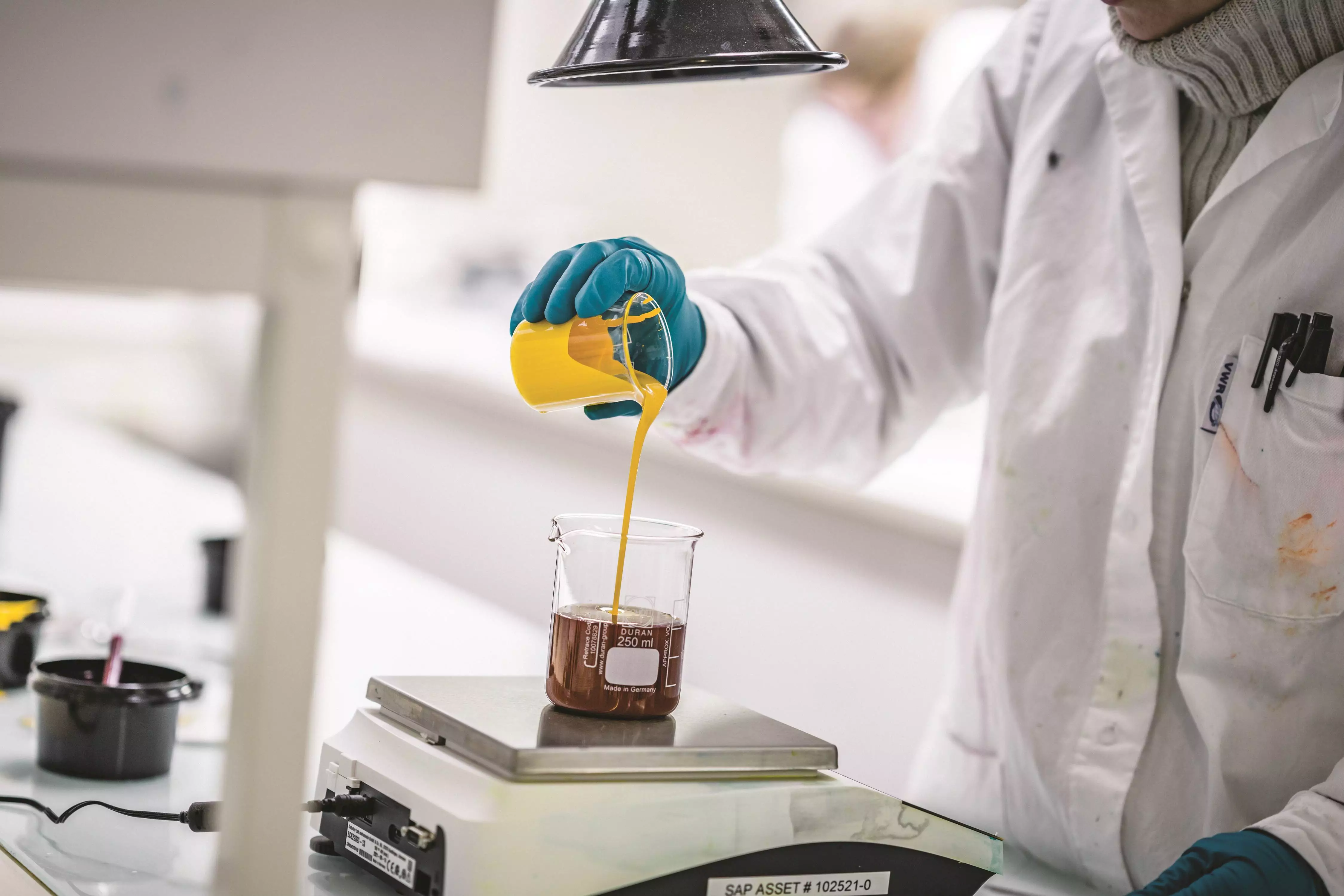
Roy: Inks must be considered as anon-biodegradable component of a packaging material and fall under the 1% limit of packaging per colour
ND: The reduction of volatile organic compounds (VOCs) contributes to lower greenhouse gases, a better working environment and the use of renewable resources. How is India doing?
UR: The packaging industry in India is doing its bit to contribute to reducing VOCs. There is a focus on using mono-solvent ink followed by solvent recovery via a recovery plant. The solvent can be recovered and reused after distillation instead of releasing to the environment. Approximately 80% recovery is possible. It will help in limiting the VOCs to the environment.
ND: How can water-based inks/EB curing help to achieve the same?
UR: VOC contribution of water-based inks and UV/EB curing inks is almost zero, although energy consumption is relatively high for using these technologies. We need to find the balance between VOC exposure to the environment and the use of energy to get the optimum benefit of these two technologies.
ND: How to pursue technology in a circular economy, both for recycling the finished packaging products as well as utilising recycled material as raw material?
UR: Flexible packaging, always hailed as a sustainable and resource-efficient alternative to rigid packaging, is now being challenged regarding its recyclability. There is a big challenge for technology experts to find a solution which meets the requirement for the product to be packed in terms of shelf life and keep it fit for its purpose, and, subsequently, it should be recyclable.
ND: Is utilising the recycled material possible?
UR: Yes, but care should be taken to maintain the compliance requirements for the format where it will be used. Usability for non-food packaging is simpler, but using it for food packaging requires stringent control and quality checks.
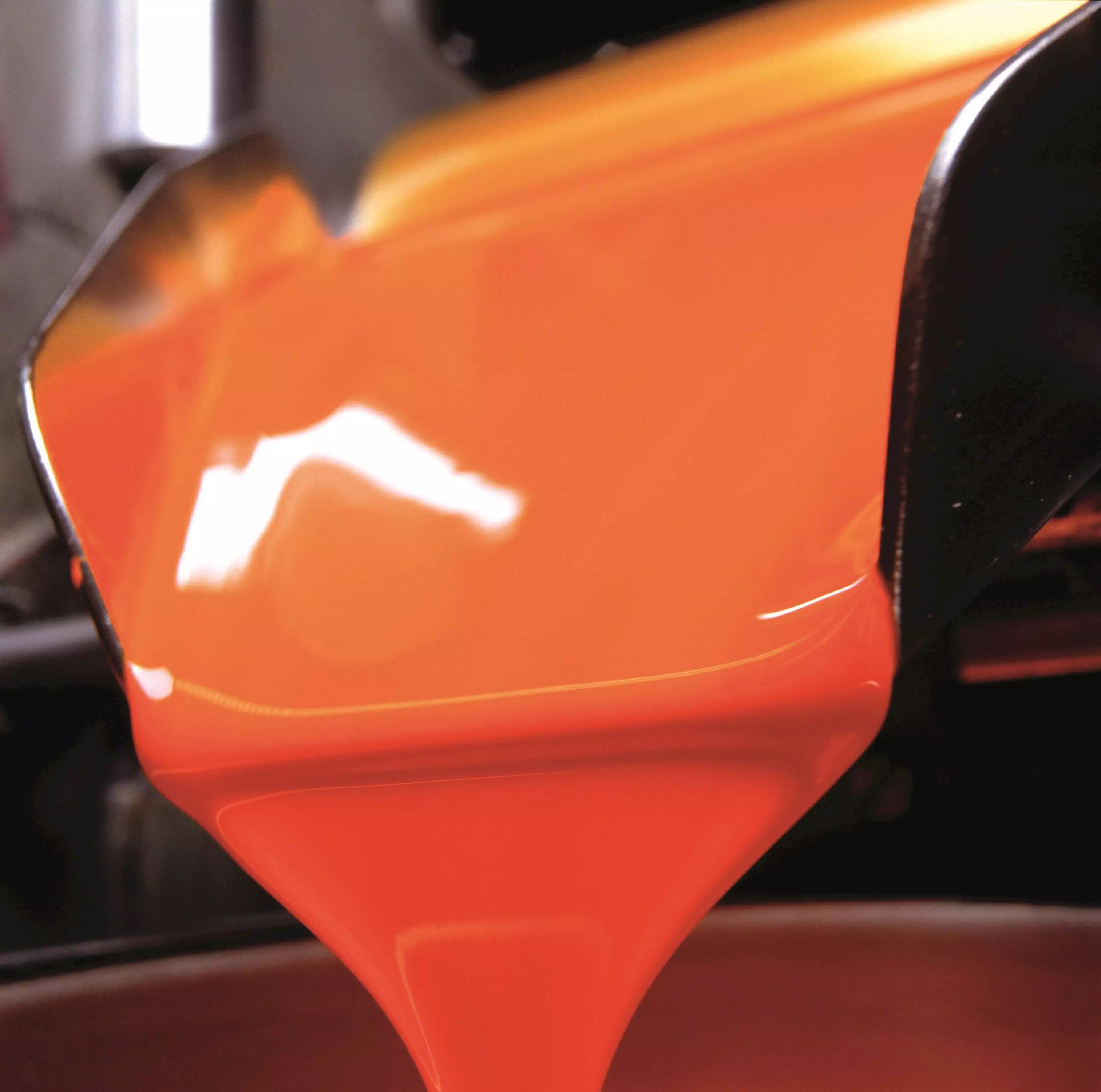
Flint ink sample
ND: How is the journey of mono material, mono layer, plastic to paper progressing?
UR: We have worked with converters to come up with solutions for mono-layers. The challenge, again, is to make it cost-effective. Keeping a price point that is economical for the Indian market is key. The competitiveness of the price point is something that needs more work.
ND: Is moving to paper from plastic a challenge?
UR: It is a challenging task with respect to the barrier and strength of the packaging material which is solely made out of paper. Multinational firms in India are keeping close eye on the trends which are happening globally and making themselves equipped to follow the same in India.
ND: Please share the highlights of Flint’s raw material lab in India, and how you source responsibly and manage the cost of your finished products?
UR: The lab was set up in the middle of the Covid-19 pandemic. During this period, we were looking at mitigating the impact of countries going into lockdown every other week. We wanted to streamline our sourcing, which led us to set up the lab.
ND: How did you do it?
UR: Initially a lab was set up to look at flexible applications, and now it has expanded to paper and board applications, and does work not just for India but also for global Flint Group. It will play a key part in informing the products we use to operate more sustainably as we advance.
ND: How can lighter packaging and extended shelf life of packaging be encouraged through use of barrier coating in India?
UR: Reducing the number of film layers or using lower micron films with barrier coating is a viable option for lighter packaging. Film and ink manufacturers are actively pursuing this direction.
ND: What’s the current usage of barrier coating and how will it be in the next ten years’ time?
UR: The current usage of barrier coatings is minimal in the food packing industries. But it is expected to increase substantially in the future along with the drive of a circular economy.
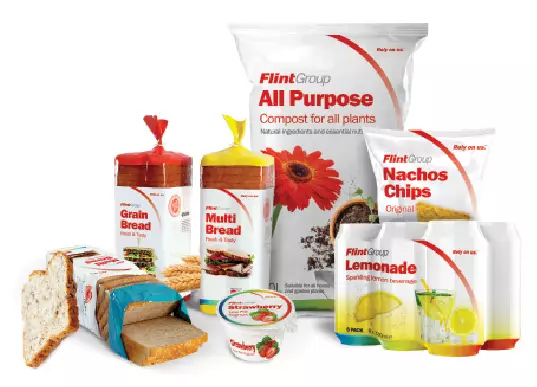
Flint’s flexible packaging collection
ND: With an increasing focus on food safety and environmental impact, how can one create a compostable package through a combination of ink and biodegradable substrates?
UR: A compostable material must meet four main requirements; for example, it must be biodegradable. Compostable packaging material can contain a maximum of 5% dry weight of non-biodegradable components. It must disintegrate. It should not negatively affect the environment and the treatment process (for example, not harmful to water organisms). The quality of the compost must not be affected.
ND: And what about designing inks for compostable packaging? What care needs to be taken?
UR: Certain requirements allow final packaging material to be compostable. This includes: standard cyan pigment Blue 15, which is copper-based, must be replaced by Cu-free blue; standard pigment green, which is copper-based, uses mixtures with Cu-free blue and yellow to make green; and no bronze or other metallic pigments are possible.
ND: Interesting point.
UR: Yes, inks must be considered as a non-biodegradable component of a packaging material and fall under the 1% limit of packaging per colour and total amount of maximum 5% for all colours.
ND: How can the Indian ink fraternity reduce industrial waste - and establish a circular economy?
UR: The industry has to work with converters but also with brand owners. No one company can work in isolation. We must educate converters and brands about what is and is not possible and the cost of use. Sometimes we look at the ultimate goal but overlook the costs of bringing a product to market.
ND: Is this doable?
UR: Ultimately, we need a lot of cost-benefit analysis. Sometimes that will mean an initially higher price point on sustainable products, but everybody must work together if it is better from an environmental perspective. It needs a leap of faith and an understanding of our ultimate goal from all stakeholders.
ND: What sort of conversations are you having with the brand owners? How can we help them understand and support the implementation of the standards according to the guidelines? After all, this will not only help from an environmental point of view, but it will also enhance their brand protection and promotion.
UR: Building that understanding will need effort from everybody, especially within the industry. The ink sector has to play a leading role in educating not just our customers but our customers’ customers – the brand owners. More education - about what is possible in the marketplace, the essential sustainability and environmental goals, and the challenges we face – is key.
ND: How so?
UR: But working together with some critical players to achieve the end goal. We can do this by laying out goals with timelines in place. If we can lay out timelines that are acceptable to all stakeholders, we will be able to make progress. That requires a three-way conversation between the industry, converters, and brands. Also we must consider new government regulations driving the sustainability conversation forward.n


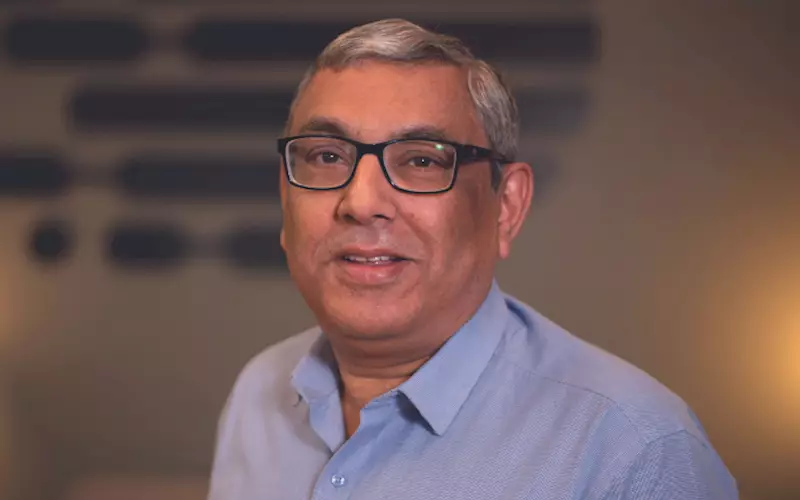








 See All
See All